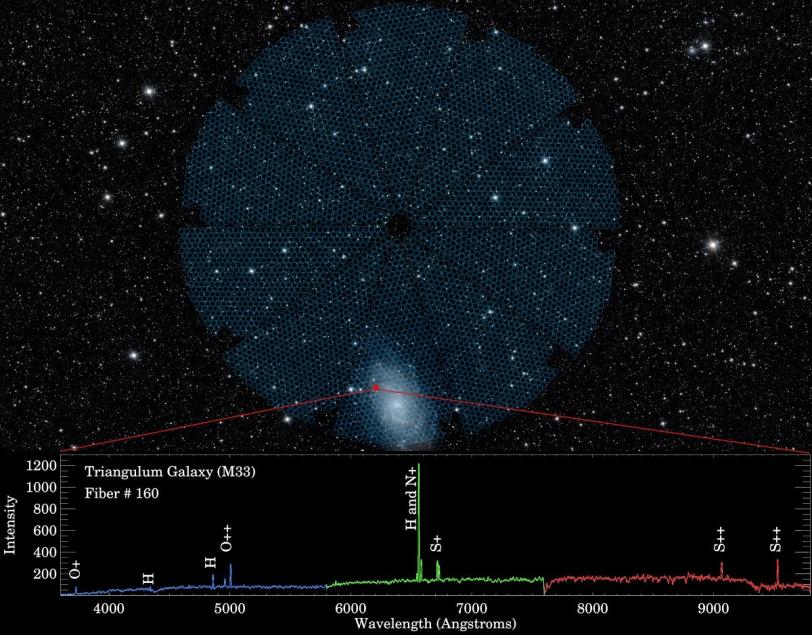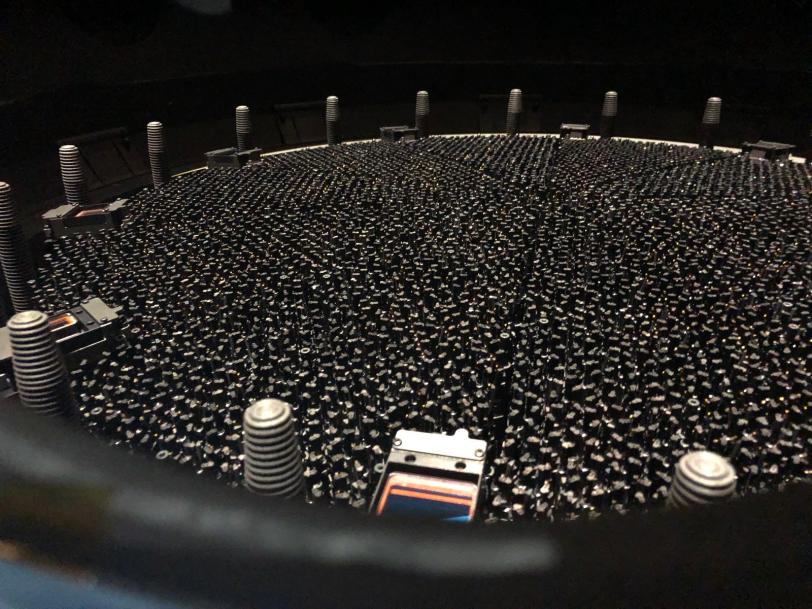DESI points 5,000 robotic ‘eyes’ at the sky to explore dark energy
The Dark Energy Spectroscopic Instrument begins final testing, setting the stage for a 5-year survey that will analyze the light of 35 million galaxies.
A new instrument mounted on a telescope in Arizona aimed its robotic array of 5,000 fiber-optic “eyes” at the night sky on Oct. 22 to capture the first images showing its unique view of galaxy light.
It was the first test of the Dark Energy Spectroscopic Instrument, known as DESI, which is now almost completed. The long-awaited instrument is designed to explore the mystery of dark energy, which makes up about 68 percent of the universe and is speeding up its expansion.

DESI’s components are designed to automatically point at preselected sets of galaxies, gather their light, and then split that light into narrow bands of color to precisely map their distance from Earth and gauge how much the universe expanded as this light traveled to us. In ideal conditions DESI can cycle through a new set of 5,000 galaxies every 20 minutes.
“After a decade in planning and R&D, installation and assembly, we are delighted that DESI can soon begin its quest to unravel the mystery of dark energy,” said DESI Director Michael Levi of the Department of Energy’s Lawrence Berkeley National Laboratory, the lead institution for DESI’s construction and operations. "Most of the universe’s matter and energy are dark and unknown, and next-generation experiments like DESI are our best bet for unraveling these mysteries.”
Risa Wechsler, former spokesperson of the DESI collaboration and director of the Kavli Institute for Particle Astrophysics and Cosmology (KIPAC), said, “It’s extremely exciting to see the instrument become a reality and the collaboration get ready for its data. DESI will be truly transformational. It’ll allow us to go 11 billion years back in time and measure ancient light with unprecedented precision. The results will be a big leap in our understanding of dark energy.”

The DESI collaboration has participation from nearly 500 researchers at 75 institutions in 13 countries, including scientists from KIPAC, a joint institute of DOE’s SLAC National Accelerator Laboratory and Stanford University. The latest milestone marks the beginning of DESI’s final testing before the formal start of observations in early 2020.
A time machine to study dark energy
Like a powerful time machine, DESI will peer deeply into the universe’s infancy and early development to create the most detailed 3D map of the universe yet.
By repeatedly mapping the distance to 35 million galaxies and 2.4 million quasars across one-third of the area of the sky over its five-year run, DESI will teach us more about dark energy. In particular, quasars – active galaxies that are among the brightest objects in the universe – will allow DESI to look deeply into the universe’s past.
As a result, DESI will provide very precise measurements of the universe’s expansion rate. Gravity slowed this rate of expansion in the early universe, but dark energy has been responsible for speeding up its expansion.
But the DESI data will go beyond determining the rate of cosmic expansion. It’ll also shed more light on how the expansion affects the way galaxies and other astrophysical objects form and grow over time.
“DESI will let us measure certain properties of the universe like never before,” said Chia-Hsun Chuang, a KIPAC research scientist working with Wechsler. He chairs a group of DESI scientists who are currently running simulations of how dark energy has impacted baryon acoustic oscillation – fluctuations in the density of matter caused by sound waves in the early universe.
Pointing 5,000 ‘eyes’ at the sky
Installation of DESI began in February 2018 at the Nicholas U. Mayall Telescope at Kitt Peak National Observatory near Tucson, Arizona.
“With DESI we are combining a modern instrument with a venerable old telescope to make a state-of-the-art survey machine,” said Lori Allen, director of Kitt Peak National Observatory at the National Science Foundation’s National Optical-Infrared Astronomy Research Laboratory.
Over the past 18 months, a bevy of DESI components was shipped to the site from institutions around the globe and installed on the telescope.
One particular technological masterpiece is DESI’s focal plane, which carries 5,000 robotic positioners that swivel in a choreographed “dance” to focus on individual galaxies.

These little robots – which each hold a light-gathering fiber-optic cable that is about the average width of a human hair – serve as DESI’s “eyes.” It takes about 10 seconds for the positioners to swivel to a new sequence of targeted galaxies. With its unprecedented surveying speed, DESI will map over 20 times more objects than any previous experiment.
The focal plane, which contains half a million individual parts, is arranged in a series of 10 wedge-shaped petals that each contain 500 positioners and a little camera to help the telescope guide, focus and align (GFA system). KIPAC researchers Kevin Reil and Aaron Roodman were involved in various aspects of the development and commissioning of the GFA camera and its software.

Analyzing ancient light
Among the more recent arrivals at Kitt Peak is the collection of spectrographs that are designed to split the gathered light into thousands of wavelengths to allow precise distance measurements of the observed galaxies across a broad range of colors.
These spectrographs, which allow DESI’s robotic eyes to “see” even faint, distant galaxies, are designed to measure redshift, which is a shift in the color of objects that are moving away from us to longer, redder wavelengths. Redshift is analogous to how the sound of a fire engine’s siren shifts to lower tones as it moves away from us.
"DESI is a very exciting project that will use these redshifts for compelling measurements of baryon acoustic oscillation and dark energy,” Roodman said. “It’s also exciting that these data will be highly complementary to data from the next-generation Large Synoptic Survey Telescope that will measure dark energy in other ways.” Both data sets combined will provide unique opportunities to study this mysterious cosmic property, he said.
There are now eight DESI spectrographs installed, with the final two arriving before year-end. To connect the focal plane with the spectrographs, which are located beneath the telescope, DESI is equipped with about 150 miles of fiber-optic cabling.
“This is a very exciting moment,” said Nathalie Palanque-Delabrouille, a DESI spokesperson and an astrophysics researcher at the French Alternative Energies and Atomic Energy Commission (CEA) who has participated in the selection process to determine which galaxies and other objects DESI will observe. “The instrument is all there. It has been very exciting to be a part of this from the start.”
Gregory Tarlé, a physics professor at the University of Michigan (UM) who led the student teams that assembled the robotic positioners and related components, said it’s gratifying to reach a stage in the project where all of DESI’s complex components are functioning together. UM delivered a total of 7,300 robotic positioners, including spares. During the production peak, the teams were churning out about 50 positioners a day.
Now that the hard work of building DESI is largely done, Tarlé said he looks forward to DESI discoveries.
“I want to find out what the nature of dark energy is,” he said. “We finally have a shot at really trying to understand the nature of this stuff that dominates the universe.”

The Making of the Largest 3D Map of the Universe
DESI, the Dark Energy Spectroscopic Instrument, will mobilize 5,000 swiveling robots – each one pointing a thin strand of fiber-optic cable – to gather the light from about 35 million galaxies. The little robots are designed to fix on a series of preselected sky objects that are up to 11 billion light-years away. By studying how these galaxies are drifting away from us, DESI will provide precise measurements of the accelerating rate at which the universe is expanding.
DESI Collaboration; Marilyn Chung/Berkeley Lab
DESI is supported by the U.S. Department of Energy’s Office of Science; the U.S. National Science Foundation; the Science and Technologies Facilities Council of the United Kingdom; the Gordon and Betty Moore Foundation; the Heising-Simons Foundation; the French Alternative Energies and Atomic Energy Commission (CEA); the National Council of Science and Technology of Mexico; the Ministry of Economy of Spain; and DESI member institutions. The DESI scientists are honored to be permitted to conduct astronomical research on Iolkam Du’ag (Kitt Peak), a mountain with particular significance to the Tohono O’odham Nation. View the full list of DESI collaborating institutions, and learn more about DESI at desi.lbl.gov.
Editor’s note: This feature is an adaptation of a news release by Berkeley Lab.
Contact
For questions or comments, contact the SLAC Office of Communications at communications@slac.stanford.edu.
About SLAC
SLAC National Accelerator Laboratory explores how the universe works at the biggest, smallest and fastest scales and invents powerful tools used by researchers around the globe. As world leaders in ultrafast science and bold explorers of the physics of the universe, we forge new ground in understanding our origins and building a healthier and more sustainable future. Our discovery and innovation help develop new materials and chemical processes and open unprecedented views of the cosmos and life’s most delicate machinery. Building on more than 60 years of visionary research, we help shape the future by advancing areas such as quantum technology, scientific computing and the development of next-generation accelerators.
SLAC is operated by Stanford University for the U.S. Department of Energy’s Office of Science. The Office of Science is the single largest supporter of basic research in the physical sciences in the United States and is working to address some of the most pressing challenges of our time.





